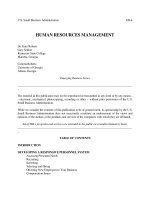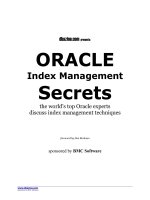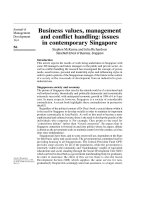Tài liệu E-Human Resource Management 30 ppt
Bạn đang xem bản rút gọn của tài liệu. Xem và tải ngay bản đầy đủ của tài liệu tại đây (884.13 KB, 9 trang )
Managing and Practicing OD in an IT Environment 247
Copyright © 2005, Idea Group Inc. Copying or distributing in print or electronic forms without written
permission of Idea Group Inc. is prohibited.
rarely connect to results, noting that most managers define positive results as
higher productivity, better quality, more profits, and lower costs. Blansfield
directly links the key processes to the managerial definition of results in his
Team Effectiveness Theory, indicating a strong, though often unacknowledged,
causal relationship (Weisbord, 1987, p. 303). The implication is clear: Focus-
ing on improving IT project teams’ processes can have a positive effect on their
results, and thus on the organizations they serve. In fact, the very act of bringing
the team to reflection about its behaviors can result in a sort of Hawthorne
effect, improving performance through the act of change despite the intent of the
change (Roethlisberger & Dickson, 1939).
Participation in decision-making processes would seem a natural operating
mode for one as highly skilled as the IT professional. Yet, project management
works at cross-purposes with participation in practice if not in theory. The
tendency in a fast-paced, high-pressure environment like IT is to control, and
one person in control can always make decisions faster than many. Project
management as a controlling mechanism may produce temporary results, but
will ultimately create more issues than would participation. Similarly, Lewin
knew that participation alone would also fail absent careful diagnosis and
application, reflecting the uniqueness of each situation (Weisbord, 1987, pp.
93-94). Involving people is more than just a technique. A truly effective IT
project team operates from an integration of the structured theory of project
management and the proven foundation of participation in the decision-making
process. The key is in finding a way to integrate the two.
Main Thrust of the Chapter
OD has a tremendous opportunity in the IT field. OD practitioners who want
jobs, influence, and an opportunity to make a meaningful difference can find all
three in IT by first building the effectiveness of the IT project team. Eric Trist
wrote, “Information technologies, especially those concerned with the micro-
processor and telecommunication, give immense scope for solving many
current problems — if the right value choices can be made” (Trist, 1981, p. 59).
More than two decades after Trist’s observation, IT is the single largest capital
investment in most organizations today (Thorp, 1998). IT drives tremendous
changes in organizations and is one of the most powerful organizational
interventions. The way IT products and services are created and deployed
248 Logan
Copyright © 2005, Idea Group Inc. Copying or distributing in print or electronic forms without written
permission of Idea Group Inc. is prohibited.
significantly influences an organization’s culture, structure, development, and
survival (Beckhard & Harris, 1987). OD practitioners seek but seldom find this
level of influence in organizations, and the IT project team provides access to
that influence. The process of creating IT products and services also produces
the issues associated with IT projects: poor communication, unclear or
competing objectives, and lack of leadership buy-in. While these issues are
common, approaches to overcoming them are not. The IT project management
process does not by itself offer mechanisms for learning and improving during
projects. The OD process does.
OD “applies behavioral science knowledge and practices to help organizations
achieve greater effectiveness” (Cummings & Worley, 1997, p. 1). The major
issues in IT projects — poor communication, lack of clear objectives, and lack
of leadership support — are targeted and minimized by OD interventions that
create participation and learning. OD addresses the issues with which IT
struggles. In this sense, the relationship between OD and IT is — or should be
— symbiotic.
Yet, IT continues to repeat its mistakes, and OD continues to be considered
more a luxury than an IT project necessity. The next section discusses the
issues, controversies, and problems that maintain distance between these
seemingly complementary fields.
Issues, Controversies, Problems
IT and OD remain distanced by differences in priorities, undefined relation-
ships, and incomplete approaches. Each pursues different — and often
conflicting — goals and values. Similarly, the relationship between IT and OD
— and the benefits of creating such a relationship — has not been defined and
does not have many models to emulate. Perhaps most important, IT and OD
continue to employ incomplete, insular approaches when more robust, comple-
mentary, and collaborative approaches are required. This section discusses
each of these issues.
Differences in Priorities
The persistent issue in the way IT projects are currently conducted is the
astounding waste in cost and schedule overruns and in unmet requirements. The
Managing and Practicing OD in an IT Environment 249
Copyright © 2005, Idea Group Inc. Copying or distributing in print or electronic forms without written
permission of Idea Group Inc. is prohibited.
human and opportunity costs of such waste are tremendous, both globally and
locally. Yet, this big problem masks an equally disturbing issue: Few people
seem to really care about solving the big problem.
IT professionals rarely occupy a level in their organizations that requires or even
offers a clear view of the organization’s strategy and finances. Their concerns
often focus on producing IT products and services that meet immediate or near-
term needs, and the boundaries of their current projects often define their
spheres of concern. The larger organizational picture is often missing. IT
professionals who do have a view of the larger organizational picture — usually
mid- to upper-level managers — are often caught up in the political struggles
common in the upper levels of organizations. While both groups believe in the
holy IT trinity of cost, schedule, and requirements, that trinity serves different
ends for each. Neither directly feels the mounting losses of IT project waste,
and almost no one comprehends the magnified costs downstream. These are
measured in lost opportunities, lost revenue, and lost jobs.
OD practitioners are seldom more strategic than IT professionals in their
orientation, but they do care about lost opportunities and lost jobs. When
markets expand, people have secure jobs and growing room (Weisbord, 1987,
p. 2). When there is waste that results in lost jobs and shrinking opportunity,
the opposite is true. OD practitioners usually work toward personal and
organizational growth, and are often stymied by the economic conditions that
make jobs less secure. Their work resides in the diagnosis and correction of
organizational issues such as poor communication, clarity about objectives, and
issues of organizational alignment and support. The espoused theory is that
eliminating these problems will produce organizations that are more productive
and rewarding places to work. The unfortunate reality is that when times get
tough, OD is considered an expendable luxury rather than a strategic tool.
Undefined Relationships
While the most common, persistent issues in IT projects are the very sorts of
issues OD addresses, few IT projects have an OD practitioner as a team
member or consider OD critical to success. The historic role of the OD
practitioner in IT projects has been limited to narrowly focused efforts such as
training, project communication, and documentation. While these functions are
important in any IT environment, the OD practitioner has far more to offer to
the IT organization. The real OD work lies within the IT project team itself.
250 Logan
Copyright © 2005, Idea Group Inc. Copying or distributing in print or electronic forms without written
permission of Idea Group Inc. is prohibited.
Why haven’t IT projects traditionally had OD practitioners as part of the team?
Three reasons immediately present themselves. First, both IT and OD value
competence, and asking for help is analogous to admitting fault. IT and OD
practitioners are experts brought into an organization to solve the toughest
problems, not to introduce new ones. Whether from arrogance or insecurity,
people in both fields often opt for working problems out alone rather than
seeking help. Second, IT and OD tend to approach issues differently. While
OD practitioners tend to take the broad, big-picture view of organizations with
the human element as a primary concern, IT professionals are narrowly focused
on the technical requirements, schedule, and cost of their particular project,
often to the exclusion of individual and organizational concerns. Yet, the most
important reason IT and OD people do not often work together is also the most
obvious: Most have never done it before.
There are very few examples of successful IT-OD partnerships. Despite failing
in exactly the areas OD seeks to improve, IT professionals tend not to notice
or value OD practitioners. Ask most IT professionals their impression of OD
and they will gladly recount the pointless teambuilding session that cost them
half a day of work or the boring “people skills” training their manager made
them attend. Ask OD practitioners about IT projects and they will likely offer
blank stares or nervous laughter. Despite having complementary needs and
talents, the two fields remain separated by ego, approach, and ignorance.
Incomplete Approaches
The field of OD has not invested the effort in defining its relationship to IT in the
same way project management has. As a result, IT professionals know little
about OD, and OD takes little notice of IT. In the past several years, OD has
become increasingly technique-focused while minimizing the importance of the
outcomes of using those techniques, a shift that runs counter to the most
pressing needs of IT. IT demands results, and OD is seldom held accountable
for them. While OD practitioners seem to believe that newer and better
techniques will produce more consistent, meaningful — though vague —
outcomes, IT continues to invest its faith in the controlling (and often creativity-
starving) mechanisms of project management, and both are the worse for it.
It seems clear that OD and IT can play a role in each other’s success, and the
challenge at this point is in defining that role. IT can no longer afford to spend
a quarter trillion dollars each year on ego and ignorance, and OD is equally
challenged in establishing its relevance and credibility. Through careful, system-
Managing and Practicing OD in an IT Environment 251
Copyright © 2005, Idea Group Inc. Copying or distributing in print or electronic forms without written
permission of Idea Group Inc. is prohibited.
atic, sensitive application of OD theory and approach within the specific
project management context of the IT project, both IT and OD can achieve the
cost savings and organizational impact as yet unrealized by each.
Solutions and Recommendations
In order to stop the cycle of IT project failure and waste, IT project teams must
learn to learn, correcting recurrent behaviors that impede their success. OD
efforts to facilitate these improvements must respect the boundaries of the
project, delivering results while working within the schedule and budget of the
IT project. Time and cost are at a premium in the IT project; this is perhaps the
strongest element of the IT culture. The OD practitioner interested in working
with IT project teams must understand that their work will be evaluated in these
terms.
The OD practitioner can contribute to the success of the IT project by using a
model for integrating IT and OD, adapting the model to each IT project with
a customized project charter, and employing a structured team-building
approach that focuses the model on the process level. Once the proper context
has been established, teambuilding is a logical first approach to addressing the
most cumbersome problems of IT. While there are many interventions that can
produce positive results in the IT project, the structured team-building ap-
proach is the one that most directly addresses the most troublesome issues in
IT projects. The goal in this approach is to promote a structured, results-driven
methodology for engaging and promoting productive learning in these projects.
Working with the IT project manager — the formal leader of the IT project —
the OD practitioner builds the team’s capacity to plan and manage its own work
within the parameters of the project’s scope, purpose, and organizational goal.
A Model for Integrating IT and OD
Differences in priorities, undefined relationships, and incomplete approaches
have impeded IT-OD collaboration. A model for integrating and defining
shared priorities, relationships, and approaches creates a way to overcome
these barriers and begin the work of developing the IT project team. The IT
Project Success Funnel is that model.









